The Third Mind in Guggenheim Museum NY

SENGAI GIBON, "The Circle, Triangle, and Square", Edo period, early 19th century, Ink on paper, 28.4 x 48.1 cm
The Guggenheim Museum New York is celebrating the 50th anniversary of it's iconic Frank Lloyd Wright building with a massive and most appropriately themed exhibition; "The Third Mind: American Artists Contemplate Asia, 1860 - 1989". The show is extensively researched and documented and includes over 250 works from more than 100 artists over an almost 150 year span. While it is always difficult to come away from a large group show with clear feelings and perceptions, it is especially true of a show exploring work who's intention is to approach the sublime, the pure, the very act of perception. Alexandra Monroe, the organizer and chief curator has attempted to assist the viewer in this task by dividing the show into seven groups chronologically and thematically: Aestheticism and Japan: the Cult of the Orient, Landscapes of the Mind: New Conceptions of Nature; Ezra Pound, Modern Poetry and Dance Theater: Transliterations; The Asian Dimensions of Postwar Abstract Art: Calligraphy and Metaphysics; Buddhism and the Neo-Avant-Garde: Cage Zen, Beat Zen and Zen; Art of Perceptual Experience: Pure Abstraction and Ecstatic Minimalism; and Performance Art and the Experiential Present: Irregular Ways of Being. The installation presents the show roughly chronologically as the viewer ascends Wright's long spiral from the ground floor to the top.
However, if the viewer begins the show at the top, in an isolated room off the spiral containing Bill Viola's "Room for Saint John of the Cross" (1983), one finds a video installation of such sublime power and clarity that will it will not only begin the journey with focus and understanding, it will carry one through the extensive exhibition with the same. Entering the dark room, one is assaulted by a shaky, swirling, noisy, windy black and white mountain landscape that jerks back and forth across the wall unsettling the feet and balance of the viewer. As one's eyes adjust to the darkness one finds a 5 foot high room filled with warm yellow, candle like light. Putting one's head next to the only window of this cell, one sees a small table on a dirt floor on top of which is a pitcher, a glass of water and a tiny monitor with a sharp, silent color image of a snow capped mountain. The room muffles the tempest roaring outside and one can soon hear the quiet recitation of devotional poems written by St John of the Cross (the Spanish poet Juan de Yepes Alvazar ) during the nine months he was kept prisoner and tortured for his beliefs in a small windowless cell too low to even stand in.

BILL VIOLA, "Room for St. John of the Cross", 1983
The extreme juxtaposition of movement and stillness, noise and quiet, outer and inner serves as a metaphor for the entire show. What Saint John of the Cross's cell is to the surrounding mountains is what Viola's piece is to rest of the exhibition; the present Guggenheim museum to the rest of the city/world; and by extension, this work to the kitsch, comedy and cacophony of the rest of the art world's Koonses, Hirsts, art auctions and the like. A wonderful work in a wonderful show, it retains all the power it had when I first saw it in the early 80's, truly a synecdoche.
Another extremely powerful piece in a room off of the spiral is Lamonte Young and Marian Zazeela's "Dream House" (1962-present), the recreation of a piece they created in their loft in downtown Tribeca. Young has installed slowly modulating standing sound waves generated by oscillators to create a "drone state of mind" which are complemented by Zazeela's abstract forms which slowly change shape with movement (of both the forms and the viewer) and are drenched in magenta lights passing through diachroic filters creating arresting 3D illusions in the pulsing sonic space. The piece curiously induces the viewer to be at the same time still and to move slowly as it gradually changes. (Heisenberg, indeed). Some viewers were lying on their backs on the soft, plush carpet, having surrendered to such a dilemma until their departure.

LA MONTE YOUNG AND MARIAN ZAZEEL, "A Dream House", 1962–present
Continuing on from these two installations to the balance of the show on the spiral, one recalls that the Guggenheim Museum is often criticized for it's architecture dominating the experience of viewing the art. But in the "here" and "now" of the present show, descending the museum's snail ramp allows a natural voyage back in time, meditating on the development of thought, culture and consciousness like an archeologist starting from the present and digging deeper and deeper into the past.
In the Performance section at the top of the spiral there are many strong pieces but Linda Montano's "Mitchell's Death" (1979) seems most moving and succinct. A single channel black and white video shows the dramatically lit artist's face covered in acupuncture needles projected about 5 feet high on the wall. Montano quietly recites writings about her lover's death from her journal accompanied by the sound of Pauline Oliveros playing an Indian ‘struti box and Al Rossi periodically ringing a Japanese temple gong. The viewer sits as in a small chapel absorbing the author's lament , the process of transformation and healing, as her incantation and stillness sooth the pain.
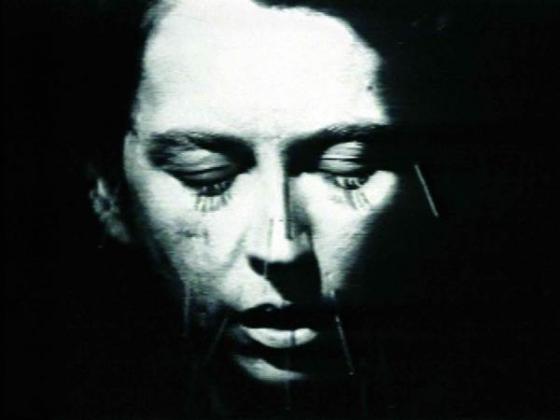
LINDA MARY MONTANO, "Mitchell’s Death", 1979
Another black and white projection is the innovatively installed "Sleep" (1963) by Andy Warhol. Here, rather than showing the film in a darkened room, it is projected edge to edge on a floating (cantilevered) screen in a dim bay along the museum spiral. This almost static film looks here like a yet unknown grainy black and white painting by Ed Rusha. Presented this way it relates strongly to the actual paintings hung the same way on the spiral like the nearby "Dancers on a Plane" (1980-81) by Jasper Johns. Additionally, with it's glacier slow movement, it could only be a painting when seen from across the huge vault of the museum. The issue of sound never comes up - of course it's silent, it's a painting... A tour de force installation underlining Warhols' brilliance.
The simplicity and presence of the above works are complemented by the large gestural wall drawing "Free Form Out of Body Circles" (2009) by Bay Area artist Tom Marioni. Drawn "in situ" with graphite on a 9 foot square sheetrock wall, the artist repeatedly drew arm length circles using his shoulder socket as a pivot, echoing the beautiful drum brush drawings he has made throughout his career using his wrists and elbows as pivots. The simple meditative lines are soothing and centering. They are fresh and new but also rich, steel-like and somehow velvety in texture at the same time, like a saxophone solo.
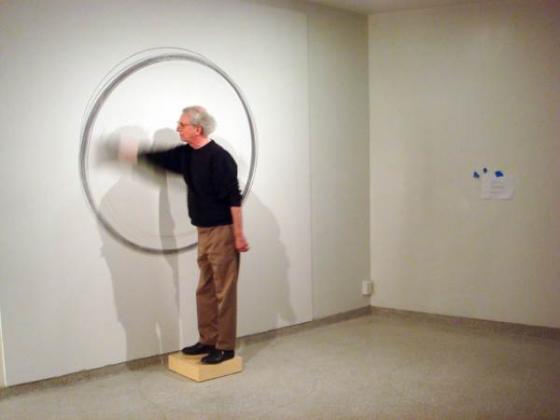
Tom Marioni rysujący okręgi, 2009
Nearby, Bill Anastasi recreated another wall piece for the show, "Issue" (1966-2009), in which the artist removed a 4 1/2 inch wide, ¼ inch deep strip of material from the wall from floor to ceiling and placed the chiseled out remnants in a 4 1/2 inch wide path on the floor. The piece both anticipates the work of Gordon Matta-Clark and sits comfortably next to a life size black and white photogram, "Sound of Two Hand Angel" (1974), by Bruce Conner, another energized figure manifest in a different medium.
My eyes were also caught by another figure, Laurie Anderson's early sound sculpture, "In the House, In the Fire" (1972 - 2000), constructed with a Tibetan singing bowl on a metal circular saw blade turning on top of a glass rod. Prerecorded electronic sounds and voice vibrate up the glass rod and transform the metal into a speaker filling the darkened space around it with a mantra like sound. This meditative, mesmerizing and solitary work brought back memories of other early Anderson pieces like her ‘arm-bone-table-speaker', so intimate and subtle ,so unlike her later theatrical performance work.
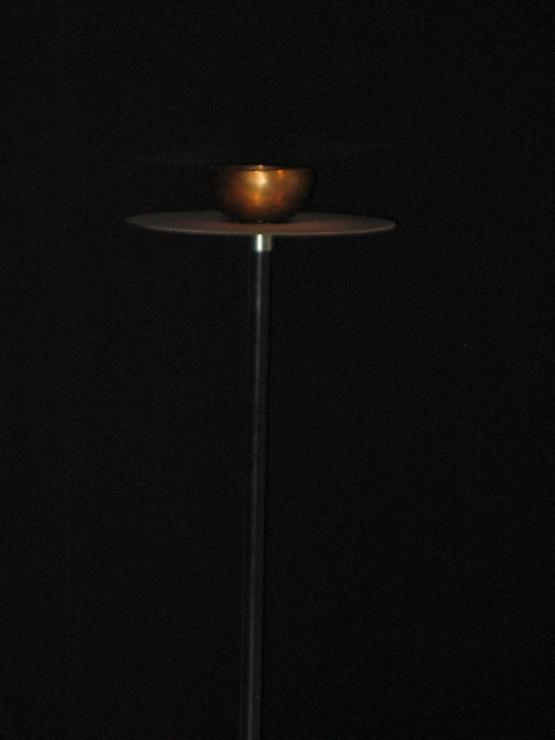
LAURIE ANDERSON, "In the House. In the Fire", 1972-2002
Another significant section, Perceptual Art, has important works by the dean of the light artists, Robert Irwin, who succinctly said "the subject of art is aesthetic perception". Other artists using light are Doug Wheeler, James Turrel and Dan Flavin, while artists in this section using more traditional materials include Ad Reinhart, Agnes Martin, Yayoi Kusama and Richard Tuttle.
As one moves down the ramp, one is of course reminded of the seminal ground breaking work done by John Cage, Nam June Paik, Yoko Ono, the rest of the Fluxus artists and the indispensable influence of the Beats; Allen Ginsburg, Jack Kerouac, William Burroughs and the gang. (The title of the show comes from William Burroughs and Brion Gysin's collaborative work, referencing both Buddhism's "third eye" and the synergy of two minds working together to create a third). All of the above are represented with major works, from John Cage's scores and drawings to Nam June Paik's "Movie for Zen" to Yoko Ono's instructions for making paintings to Kerouac's scroll text from "Dharma Bums" and of course, the cut ups by Burroughs and Gysin.
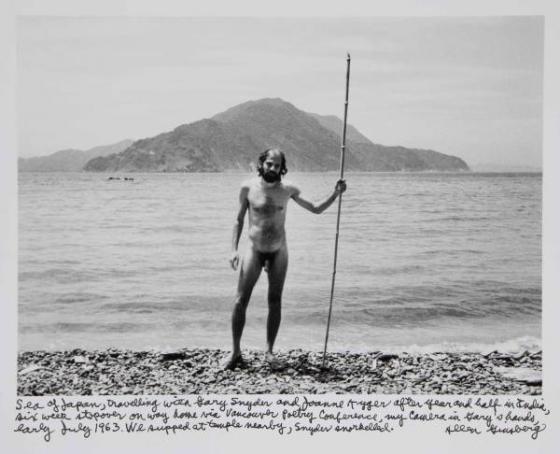
ALLEN GINSBERG, "Sea of Japan", 1963
The following two sections explore American artists response to Asian calligraphy all the way from the exquisite work by Mark Tobey and Phillip Guston to the later pale, yet flamboyant gestures by Brice Marden and then the American's take on nature represented by artists like Arthur Dove, Georgia O'Keeffe and Alfred Steiglitz.
The exhibition is large and complex, but even in a show of this size, some artists are inevitably overlooked; Terry Fox, Masashi Matsumoto, and Alan Saret come immediately to mind. However, a favorite in the show for many viewers seems to be James Lee Byers' "The Death of James Lee Byers" (1982-1994), a huge cathedral ceilinged five sided room with a body sized plinth on the floor, all covered with gold leaf, shimmering in bright lights like a Hollywood version of an Egyptian-style crypt.
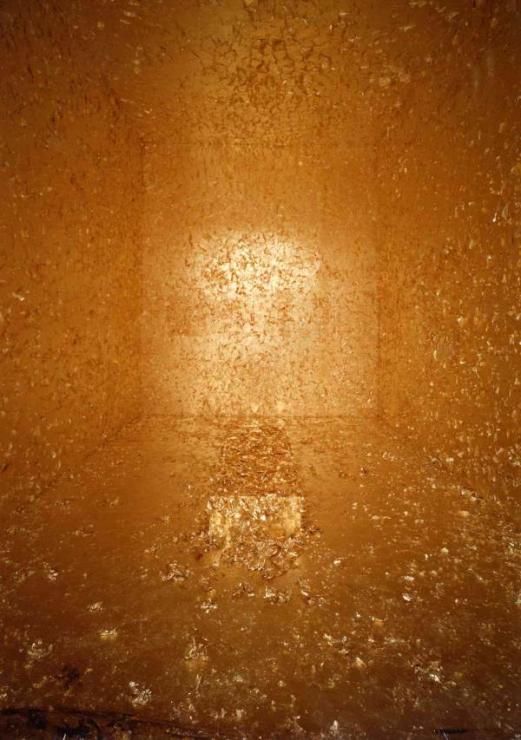
JAMES LEE BYARS, "The Death of James Lee Byars", 1982/1994
Further down the ramp is the earliest work in the show, John La Farge's 1862 painting of a water lily following almost immediately in the wake of the opening of Japan to the west by Commodore Matthew Perry and the fleet in 1853-54. In the group from the same period, among many, we can find a couple of works influenced by Japanese prints by "American Impressionist" Mary Cassatt, along with some misty, serene landscapes by expatriate James McNiell Whistler which seem to be read as capturing some kind of Asian sensibility, although to this viewer's eye they much more to resemble the work of J.M.W. Turner.
As we arrive down to the ground floor we are greeted by "Sound of Ice Melting" (1970), a prescient piece by Paul Kos, another wonderful Bay Area artist.

PAUL KOS, "Sound of Ice Melting", 1970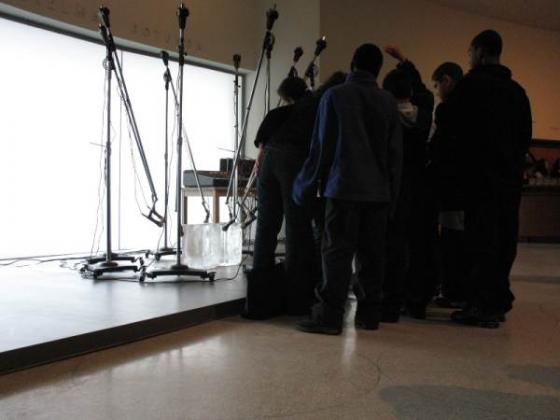
PAUL KOS, "Sound of Ice Melting", 1970
It is the first thing we see across the rotunda when we arrive and the last thing we see as we leave. Two twenty-five pound blocks of ice are silently melting away surrounded by several microphones on booms. The melting water drains toward a fogged and dripping frosted glass window behind which is our noisy, overheated world. One doesn't want to leave.
The Third Mind: American Artists Contemplate Asia, 1860 - 1989 is at the Guggenheim Museum New York until April 19, 2009 with lectures, panel discussions and performances by Marina Abramovic, Laurie Anderson, Jung Hee Choi, Merce Cunningham, Tom Marioni, Merideth Monk, Yoko Ono, and Lamont Young and Marian Zazeela.
See film on: http://www.guggenheim.org/new-york/exhibitions/on-view-now/third-mind

JOHN CAGE, "New River Watercolor Series I", #5, 1988
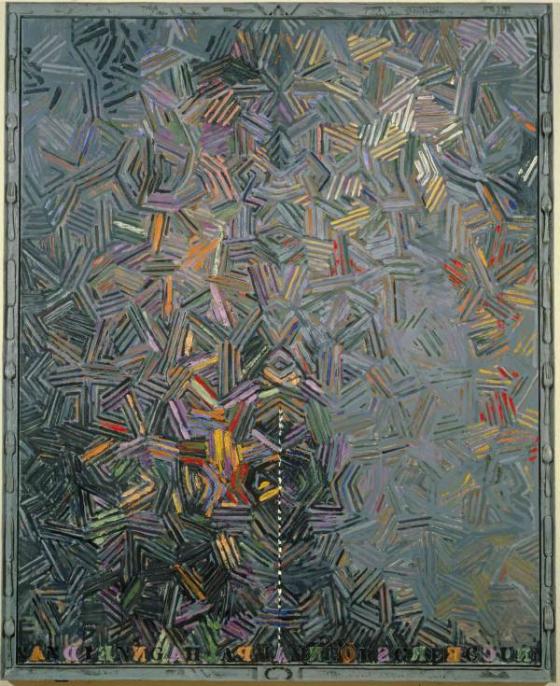
JASPER JOHNS, "Dancers on a Plane", 1980–81

MARK TOBEY, "Crystallizations", 1944

BRICE MARDEN, "Cold Mountain Studies 10", from a series of thirty-five sheets, 1988–90
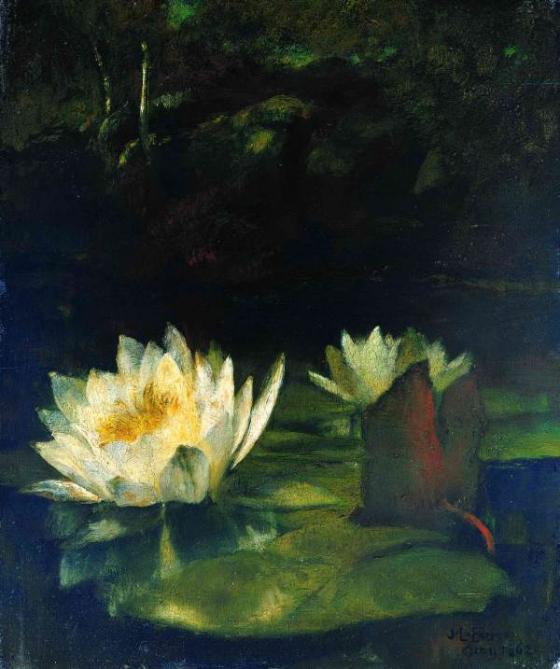
JOHN LA FARGE, "The Last Waterlilies", 1862
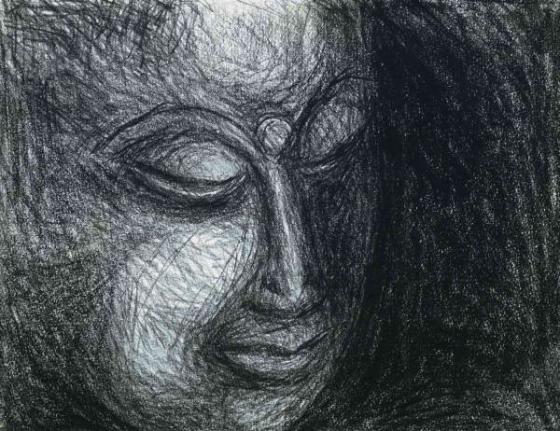
JACK KEROUAC, "Face of the Buddha", 1958?

